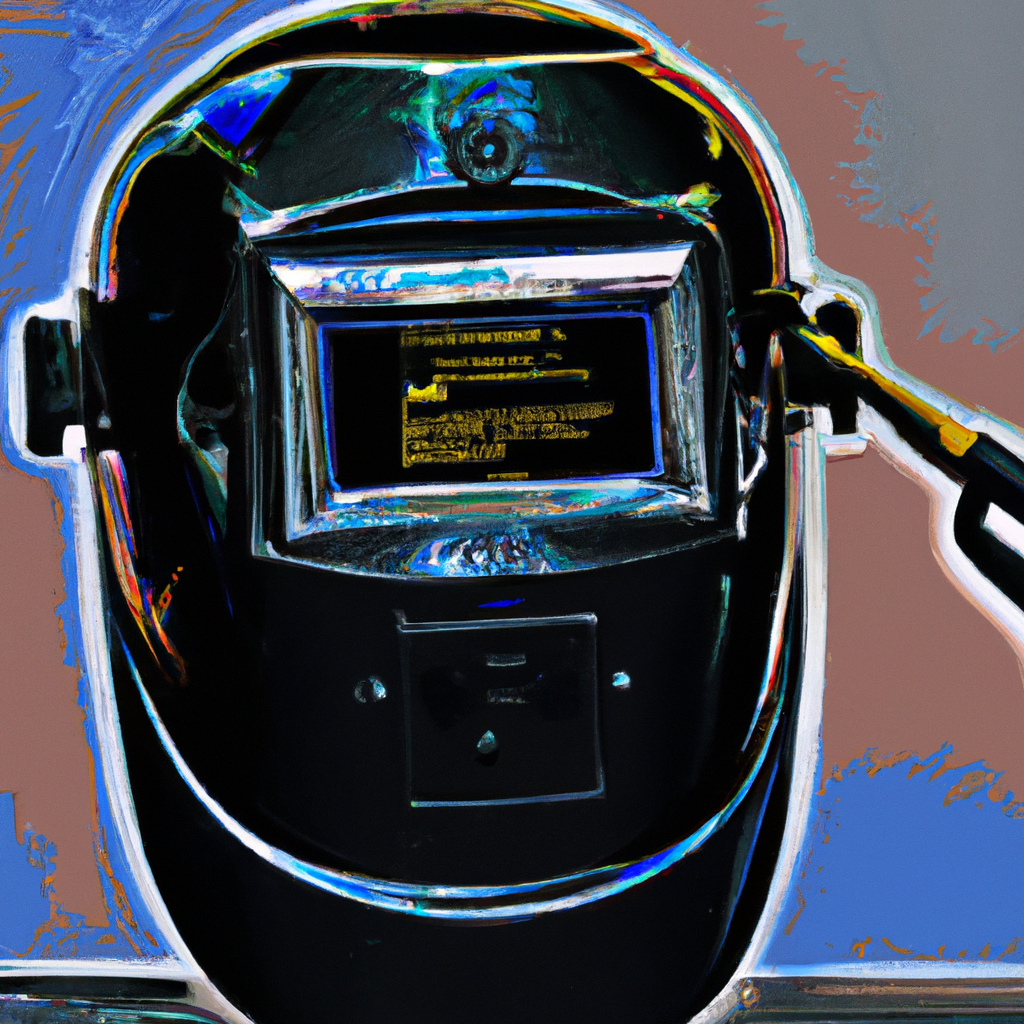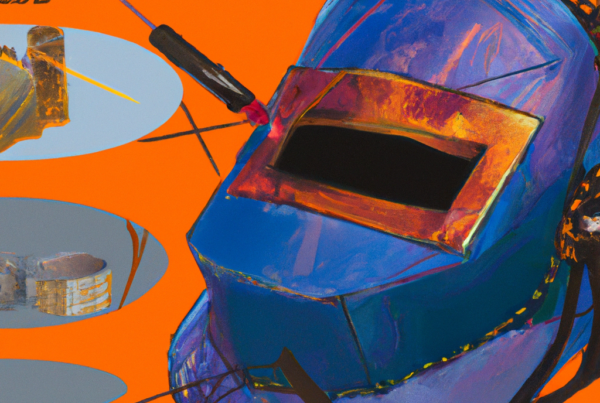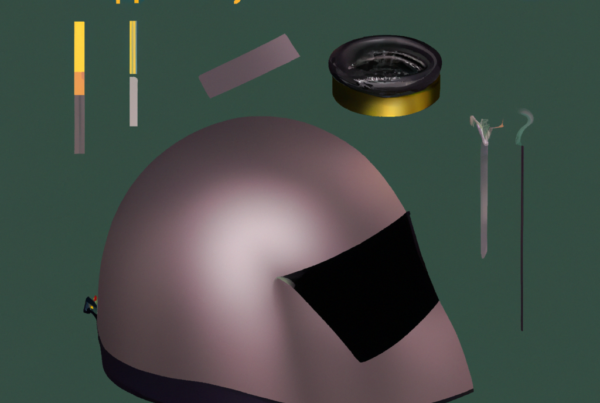Welding is an important part of many industries, but it can also be an incredibly dangerous activity. One of the most important safety precautions is to make sure you have the right welding helmet. Not only does the helmet protect your head and face from sparks and spatter, but it’s also important to make sure the helmet has the right shade of darkness. Too dark and you can’t accurately see what you’re welding, too light and you risk damaging your eyesight. Finding the perfect balance is key to welding success, so let’s explore how dark your welding helmet should be.

What type of welding am I doing?
When you are welding, it is important to ensure that your welding helmet is set to the proper shade for the task. Your welding helmet should be set to the right shade to protect your eyes and face from the bright light that is generated from the welding process. The shade that you use will depend on the type of welding that you are doing and the materials you are welding.
The most common type of welding is arc welding, which is when an electric arc is used to heat and join two pieces of metal together. For arc welding, a shade 10 or 11 is generally recommended for protection from the intense light that is generated during welding. If you are working with thicker materials, you may need to use a darker shade, such as a 12 or 13.
Gas metal arc welding (GMAW), also known as MIG welding, is a type of welding that uses a consumable wire electrode and a shielding gas. For GMAW welding, a shade 11 or 12 is recommended for optimal protection.
Gas tungsten arc welding (GTAW), also known as TIG welding, is a type of welding that uses a non-consumable tungsten electrode and a shielding gas. For GTAW welding, a shade 10 or 11 is recommended for optimal protection.
In general, most helmet shades are adjustable between 8 and 14, which gives you a range of options for your welding helmet. When selecting a shade, it is important to choose one that is appropriate for the type of welding you are doing and the materials you are welding.
What are the safety standards for welding helmets?
When it comes to welding helmets, safety is the number one priority. A welding helmet is one of the most essential pieces of safety equipment for welders, as it protects them from harmful ultraviolet and infrared radiation. So, how dark should your welding helmet be?
The darkness of your welding helmet is determined by its shade number. Shade numbers range from #8 to #13, with #8 being the lightest and #13 the darkest. The American National Standards Institute (ANSI) recommends that welders use a welding helmet with a shade number between #9 and #13, depending on the type of welding they are doing. For example, when welding with an electric arc, a shade number of #10 is recommended, while for gas welding, a shade number of #12 is recommended.
In addition to the shade number, there are other important safety considerations when it comes to welding helmets. ANSI recommends that all welding helmets be equipped with a filter plate and cover lens, and that they be constructed from materials that are resistant to heat, sparks, and spatter. It is also important that welding helmets have a wide viewing area and be comfortable to wear. Finally, the welding helmet should be equipped with an auto-darkening filter that darkens the helmet automatically when the arc is struck.
By following these safety standards, welders can ensure that they are using the right welding helmet for their job. By selecting a welding helmet with the right shade number, filter plate, and auto-darkening filter, welders can protect themselves from harmful radiation while working.
What is the correct shade for my welding helmet?
When it comes to selecting the right shade for your welding helmet, it is important to understand that the shade should be based on the type of arc welding process you plan to use. It is also important to understand that the shade should be selected to protect your eyes from the harmful rays of the welding arc.
Here is a guide for selecting the correct shade for your welding helmet:
- For Stick/Arc welding (SMAW) – Shade 11 or 12
- For Gas Metal Arc Welding (GMAW) – Shade 9, 10, 11 or 12
- For Gas Tungsten Arc Welding (GTAW) – Shade 10, 11, 12, 13 or 14
- For Air Carbon Arc Welding (CAC-A) – Shade 10, 11 or 12
- For Plasma Arc Welding (PAW) – Shade 10, 11, 12 or 13
It is recommended that you use the highest shade that you are comfortable with. Generally, a shade of 8-13 will provide adequate protection for most welding applications. If you are working in high-glare areas or on reflective metals, a higher shade (14-16) may be necessary. Additionally, it is important to note that shades 14 and above may not be suitable for all welding applications.
It is important to note that the shade number should not be confused with the darkness of the lens. The shade number refers to the amount of protection the lens provides and not its darkness. The higher the shade number, the more protection the lens will offer.
In conclusion, when selecting the correct shade for your welding helmet, it is important to consider the type
What are the risks of using the wrong shade of welding helmet?
Welding helmets are essential for protecting your face, eyes, and neck from the intense heat and light generated by welding. However, if you choose the wrong shade of welding helmet, there are serious risks involved. Here are some of the risks of using the wrong shade of welding helmet:
- Blindness: If the shade of the welding helmet is not dark enough, the welder will be exposed to the ultraviolet and infrared rays generated by the welding arc, which can cause permanent eye damage and blindness.
- Skin Damage: The intense heat and light generated by welding can cause severe sunburn and skin damage if not properly protected. Using the wrong shade of welding helmet can leave the skin exposed to harmful radiation.
- Burns: If the welding helmet is not dark enough, the heat and light generated by the welding arc can cause severe burns to the face, neck, and other exposed areas.
It is important to choose the right shade of welding helmet to ensure the utmost safety and protection. The shade of the welding helmet should be dark enough to block the ultraviolet and infrared rays generated by the welding arc, but still allow the welder to see the weld. Generally, a shade of #10 to #14 is recommended for most welding applications.
What is the shade number system for welding helmets?
Welding helmets are designed to protect your eyes and face from the bright light and intense heat generated during welding. To ensure your protection, it is important to select the proper shade number for your welding helmet.
For most welding processes, the recommended shade number is #10. This shade provides enough protection from the bright light without compromising your visibility of the welding area. For certain welding processes, such as gas tungsten arc welding (GTAW) and plasma arc welding (PAW), a darker shade is required. In these cases, a shade number between #11 and #14 is recommended.
The shade number of a welding helmet indicates the amount of light it will block. The higher the number, the darker the helmet and the more protection it provides. Here is a breakdown of the shade number system for welding helmets:
- Shade #8 – Blocks 85% of visible light.
- Shade #9 – Blocks 95% of visible light.
- Shade #10 – Blocks 99.9% of visible light.
- Shade #11 – Blocks 99.98% of visible light.
- Shade #12 – Blocks 99.99% of visible light.
- Shade #13 – Blocks 99.995% of visible light.
- Shade #14 – Blocks 99.998% of visible light.
When selecting a welding helmet, it is important to consider the type of welding process you will be performing. For most welding processes, a shade number of #10 is recommended. For certain welding processes, such as GTAW and PAW, a darker shade is required. It is also important to
What is the difference between a standard welding helmet and a variable shade welding helmet?
A standard welding helmet has a fixed shade lens that provides a single level of protection for the welder’s eyes and face. A variable shade welding helmet, on the other hand, is equipped with a lens that can be adjusted to different levels of darkness. This allows the welder to choose the right level of protection for their task.
Here are some of the advantages of a variable shade welding helmet:
- The welder can adjust the shade of the lens to the welding task at hand, providing more protection when needed.
- The helmet provides a better view of the welding area.
- It is easier to see the weld puddle and more accurately judge the amount of heat needed.
So, how dark should your welding helmet be? The answer depends on the type of welding you are doing. Low amperage welding such as TIG or MIG requires a shade of 10 or below. For medium to high amperage welding, a shade of 11 to 14 is recommended.
It is always important to follow safety protocols when welding. Using a variable shade welding helmet allows the welder to adjust the shade to the task at hand and provide the best protection for their eyes and face while welding.
How do I know when I have the correct shade of welding helmet?
When selecting a welding helmet, the most important factor to consider is the shade of the lens. Choosing the right shade will protect you from the intense light and UV rays produced during welding. Here are some tips to help you select the correct shade for your welding helmet:
- The welding helmet shade should be based on the type of welding you are doing. For example, if you are doing low-amp welding, a shade 8 or 9 would be suitable. For medium-amp welding, a shade 10-12 is best. For high-amp welding, a shade 13-14 is recommended.
- It is also important to consider the type of material you are welding. For example, if you are welding stainless steel, a shade 13-14 is recommended.
- It is recommended to use a darker shade of welding helmet if you are welding in areas with poor visibility, such as outside in bright sunlight.
- The correct shade should provide you with a clear view of the welding area without causing any strain on your eyes.
When selecting a welding helmet, it is important to ensure that you choose the correct shade that is suitable for the type of welding you are doing. The shade should provide you with clear visibility of the welding area without causing any strain on your eyes.
What are the benefits of using a welding helmet with a variable shade?
Welding helmets with variable shades offer several advantages over helmets with fixed shades. The most notable of these is the ability to adjust the shade level for different types of welding. With variable shades, welders can switch from a lighter shade when welding thin metals to a darker shade when welding thicker metals, allowing for a better view of the weld area and improved safety.
The adjustable shade levels also provide more protection from harmful UV and infrared rays, which can cause permanent eye damage. Variable shades also reduce eye fatigue, enabling welders to work for longer periods without experiencing eye strain. Additionally, many variable shade helmets come with additional features such as auto-darkening, which automatically adjusts the lens shade when welding begins, and grind mode, which allows welders to quickly switch from welding to grinding without having to remove their helmet.
When choosing a welding helmet with a variable shade, it is important to select a lens with the right shade level for the type of welding you plan to do. Generally speaking, lighter shades are best for thin metals, while darker shades are best for thicker metals. However, the exact shade level will depend on the type of welding you are doing and the type of material you are working with. It is always a good idea to consult with an experienced welder or welding supply store for advice on the best shade level for your specific needs.
How do I adjust the shade of my welding helmet?
When welding, it is important to adjust the shade of your welding helmet to the appropriate level of darkness. This will protect your eyes from the high-intensity light produced by the welding arc. To adjust the shade of your welding helmet, follow these steps:
- Turn the helmet on and make sure that the lens is in the up position.
- Look at a light source, such as a welding arc, and adjust the shade of the helmet until it is comfortable to look at.
- The ideal shade setting for welding is usually between 8 and 12.
- Once the desired shade is achieved, test the helmet by looking at a light source from a distance of about 10 inches.
- If the light is too bright, adjust the shade to a higher number. If the light is too dim, adjust the shade to a lower number.
It is important to note that some welding helmets have a maximum shade setting of 12, while others may have a maximum shade setting of 14. Be sure to read the manufacturer’s instructions to determine the maximum shade setting for your welding helmet. The ideal shade setting for welding is usually around 8-12, but it can vary depending on the type of welding you are doing and the intensity of the welding arc.
Is a Welding Helmet Dark Enough to Protect Your Eyes During an Eclipse?
Welding helmet safety during eclipses is a crucial consideration for individuals working with welding equipment during such celestial events. While welding helmets are generally designed to shield the eyes from bright light, they are not adequate for protecting against the intense rays emitted during an eclipse. Specialized eclipse glasses or a welding helmet fitted with a shade specifically made for solar eclipses should be used to ensure the safety of one’s eyes.
What other safety precautions should I take when welding?
When welding, it is important to take the necessary safety precautions to ensure your safety. Here are a few important safety tips to keep in mind:
- Wear the appropriate protective gear, such as a welding helmet, gloves, long-sleeved shirt, and long pants.
- Ensure that your work area is well ventilated and free of flammable materials.
- Make sure to check your equipment for any potential hazards before using.
- Never weld in a confined space.
- Know the risks of welding and take the necessary precautions to avoid them.
When selecting a welding helmet, it is important to choose one that is dark enough to protect your eyes from the bright light of the welding arc, but not too dark that it restricts your vision. The ideal shade for a welding helmet is between #8 and #13. The higher the number, the darker the shade. It is important to make sure that your welding helmet is properly adjusted and fits snugly so that it won’t slip off or interfere with your vision.



